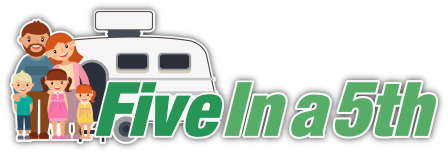“Hey sir, your trailer was making a loud noise when you were turning just now”.
That’s what the man trying to get my attention from across the parking lot was telling me. I had just parked our 5th wheel in the truck parking area at a truck stop in southeast Colorado and was walking into the store to grab a snack and use the restroom. We were on our way from Amarillo to Denver and had just finished crossing the Oklahoma panhandle. Sorry Oklahoma, but that was a bumpy road.
“It makes loud creaking noises when it turns. That’s normal. But thanks for telling me. I’ll check it out just in case there’s a problem.” That’s what I said back to him.
After I got back outside from grabbing a coke, I decided to look under the 5th wheel for anything suspicious. Then I noticed it. The leaf spring bracket, where the leaf spring attaches to the trailer frame, was bent to the side. As I looked closer, I noticed the welds holding it to the frame were cracked.
Aaaah, great. I’m glad that guy said something. Now what do we do?
After considering the situation and debating with myself whether to continue on the 2 hours to Denver or find a repair shop, I decided it wasn’t worth the risk of ending up on the side of the road with a broken leaf spring or worse. So I quickly googled for a trailer repair shop.
What luck! There was a trailer repair shop within 1 mile. The only one within 100 miles or more.
We quickly drove to the shop and discussed the situation with the shop foreman. He didn’t have the parts to completely fix it, but he could try to straighten and reweld the bracket so we could at least get to Denver.
An hour later and we were back on the road. The rest of the drive went as planned and we made it to our destination in Denver.
The bracket is still bent and the right rear tire is slightly out of alignment, causing the tire (which is only a month or so old) to wear along one edge. After calling several places in Denver, I found an axle repair shop willing to work on it. I’ll be taking it in before we leave Denver since I don’t dare to drive any long distance on it. How easily they can fix it and how much it will cost remains to be seen. I’ll give an update in the next post.
Now about Denver.
As some of you reading this may know, two of the kids have a rare metabolic disorder. I won’t go into all the details here, but the main complication with this disorder is they are unable to metabolize fat. Which leads to other complications, but also means they can’t ever fast. Meaning they have to eat every few hours or they will be in serious trouble as their body runs out of fuel.
So the main reason we came to Denver was to attend a conference of families with rare metabolic disorders. This conference happens every two years at a different location around the U.S., but always near a major city with a team of experts specializing in metabolic disorders.
It was a wonderful opportunity to meet and connect with other families dealing with these complications, along with meeting and hearing from the top specialists in the country on these rare genetic disorders. One of the conference speakers, Dr. Longo from Salt Lake, diagnosed Nathan when he was 5 months old. We hadn’t seen Dr. Longo in 8 years, but he remembered us right away and was excited to see Nathan’s progress.
Nathan and Abby were thrilled to meet other kids with similar disorders and enjoyed playing and spending time with them. It was such a learning experience for all of us and a rare opportunity to talk with other parents in our situation.
Making Money
When we were in Dallas, we visited the Bureau of Engraving and Printing, where U.S. paper currency is printed. So when we found out there is a U.S. Mint in Denver, we just had to go on a tour.
While the Bureau of Engraving and Printing makes the paper money, the U.S. Mint makes the coins. The Denver mint can produce up to 50 million coins per day, based on the level of demand from the banks. Over half of those coins are usually pennies.
The kids got very interested in starting to collect coins after touring the mint. They got started by getting a shiny new West Virginia Harper’s Ferry National Historic Park. The mint is producing 55 different quarters for the National Park Quarters collection program, one for a national park or monument in each state and territory.
The mint is a pretty cool visit and definitely a great field trip for homeschoolers. We even got to see some real gold bars after learning the Denver Mint stores 17% of the country’s gold reserves.











